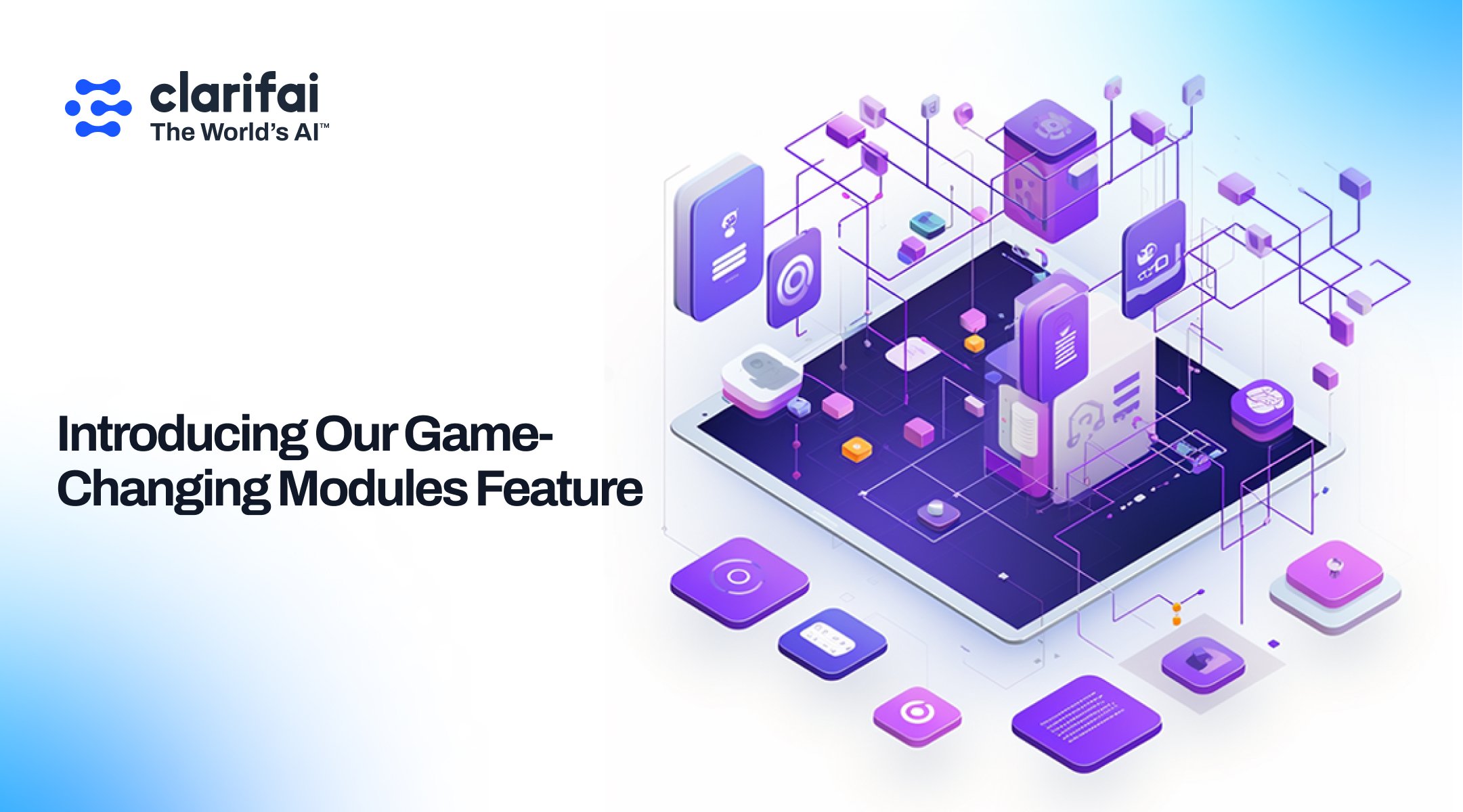
Welcome to a new era of Clarifai development as we proudly introduce the 9.6 release, featuring our game-changing Modules. Clarifai is privileged to sit on the cutting edge in a technological world constantly thirsting for progress, helping developers' and data scientists' create powerful, efficient AI-building tools.
As AI developers, you know the pain tips — complexities in integrating UI elements into your applications or coupling together multiple toolchains for backend processing. You know the effort it takes to streamline your AI-building workflow and increase productivity amidst a flurry of evolving trends.
The Modules feature was conceived as a solution to your AI development challenges, and we couldn't be more excited to share it with you. But first, let's whet your appetite by delving back into an inspiring day of creative and innovative brainstorming at Clarifai — our monthly Hackday.
A few months ago, I spent hours exploring the capabilities of Streamlit — a tool admired by the developer community — for rapidly creating user interfaces in Python, my preferred language. In a matter of minutes, I was not only able to understand Streamlit's functionalities but also build an engaging user interface. The revelation was universal — Streamlit could fundamentally change how developers and data scientists built AI applications.
My intense Hackday session resulted in the creation of six game-changing experiences for Clarifai. Four hours of investment yielded a wealth of opportunities to upgrade our platform. The potential was so comprehensive and impactful that we felt the urge to bring this functionality to our customers.
There was a gap between getting a tool like Streamlit running and truly leveraging it to streamline AI workflows seamlessly. We wanted to bridge this gap and alleviate recurring issues with other popular developer tools. In doing so, we envisioned a future where Clarifai users could rapidly develop and apply robust UI elements in production, benefitting both experienced developers and non-developer domain experts.
Armed with this inspiration, we charted a roadmap for integrating Streamlit into the heart of the Clarifai platform — a marriage of two resourceful tools to revolutionize the AI development process. Today, we're delighted to announce that we've turned our vision into reality. Modules — the result of this integration — are part of the Clarifai 9.6 release and are poised to significantly impact your AI development journey.
Together with Streamlit and Snowflake, we are furthering our mission to empower developers and data scientists to build potent applications swiftly and efficiently. With Modules, you can harness the combined power of AI and an intuitive UI to create a comprehensive solution tailored to your needs.
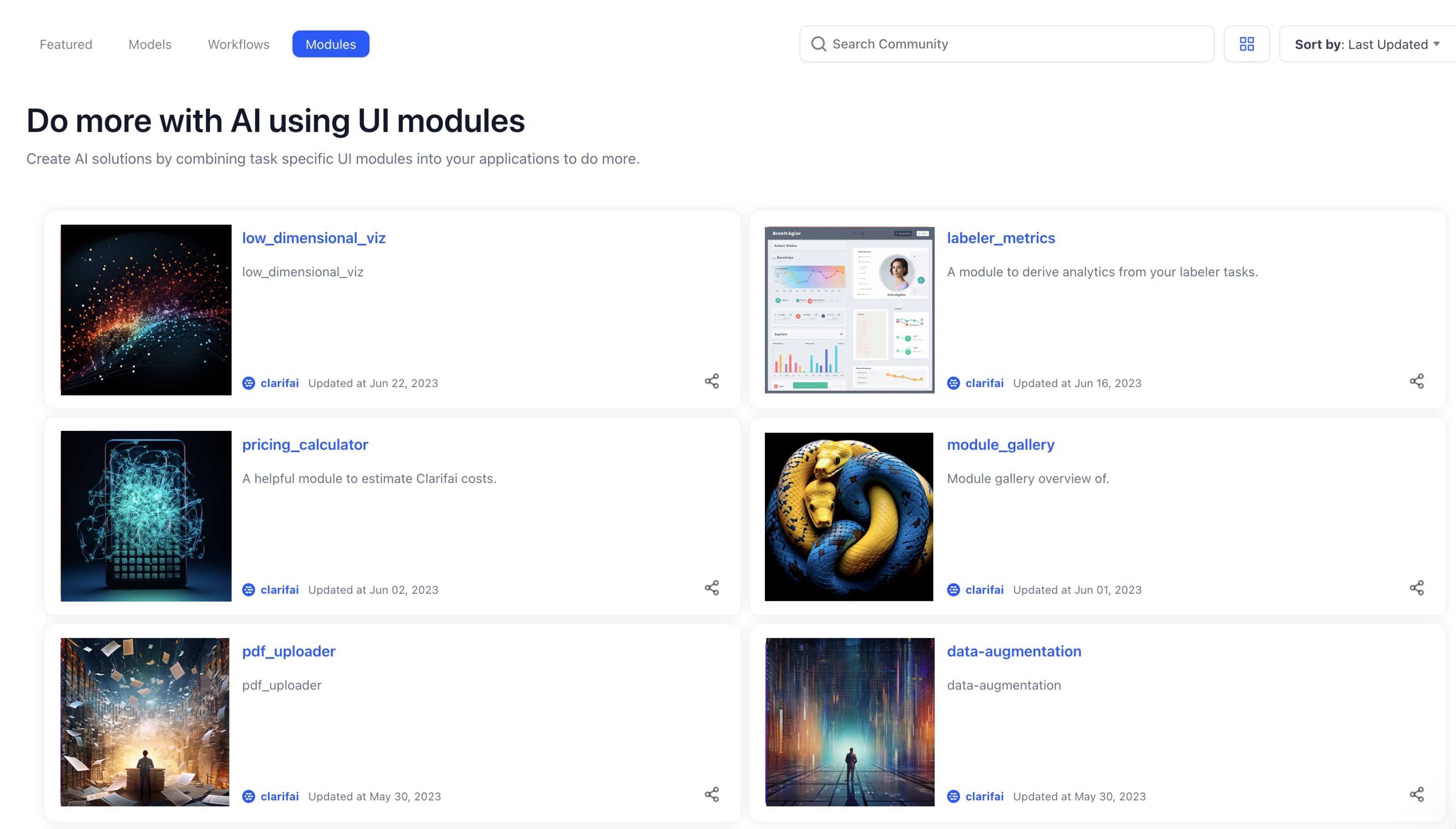
This release represents a testament to our dedication to open-source technologies and vendor-agnostic principles — tenets also shared by Streamlit. As an AI developer or data scientist, you're now equipped with a tool that promises faster, feature-rich application development. Streamlit's UI modules reflect our commitment to optimizing the Clarifai platform to streamline your AI-building processes.
Welcome to a future where your entire AI-building process — from initial development to UI deployment — occurs under one roof: Clarifai. The long process of juggling various tools is a thing of the past. With Modules, we're consolidating the AI-building environment and empowering you to deliver customized, streamlined experiences that enhance your productivity and the value you deliver to your users or customers.
Modules are here to change the game, and we're thrilled to see how you'll leverage their power to elevate your AI applications. Now, let's delve deeper into the possibilities and potential of Modules.
A significant hurdle has always been integrating UI elements into AI applications. This process often entailed a convoluted labyrinth of inefficiencies and complexities. In an environment where each user interface is critical to the functionality and user-friendliness of an application, the difficulty in seamlessly integrating these UI elements represented a substantial bottleneck in the overall development process.
Next, we confront the enduring challenge of backend processing. Developers frequently managed various tools to power their AI applications — a mix reminiscent of a digital juggling act. Not only did this eclectic array need a significant amount of time and expertise to manage, but combining the results they produced was often a complex task. This constant shuffle of tools dents progress, hampering the critical efficiency in a field marked by swift evolution and innovation.
Finally, the deployment phase presented its unique set of challenges. As developers began deploying their AI applications, they found themselves wrestling with an array of complex, often makeshift, solutions. Attempts at adapting an application — designed for what is ostensibly a uniform, smooth-run environment — for the dynamic, multifaceted deployment world were frequently fraught with potential risks and uncertainties.
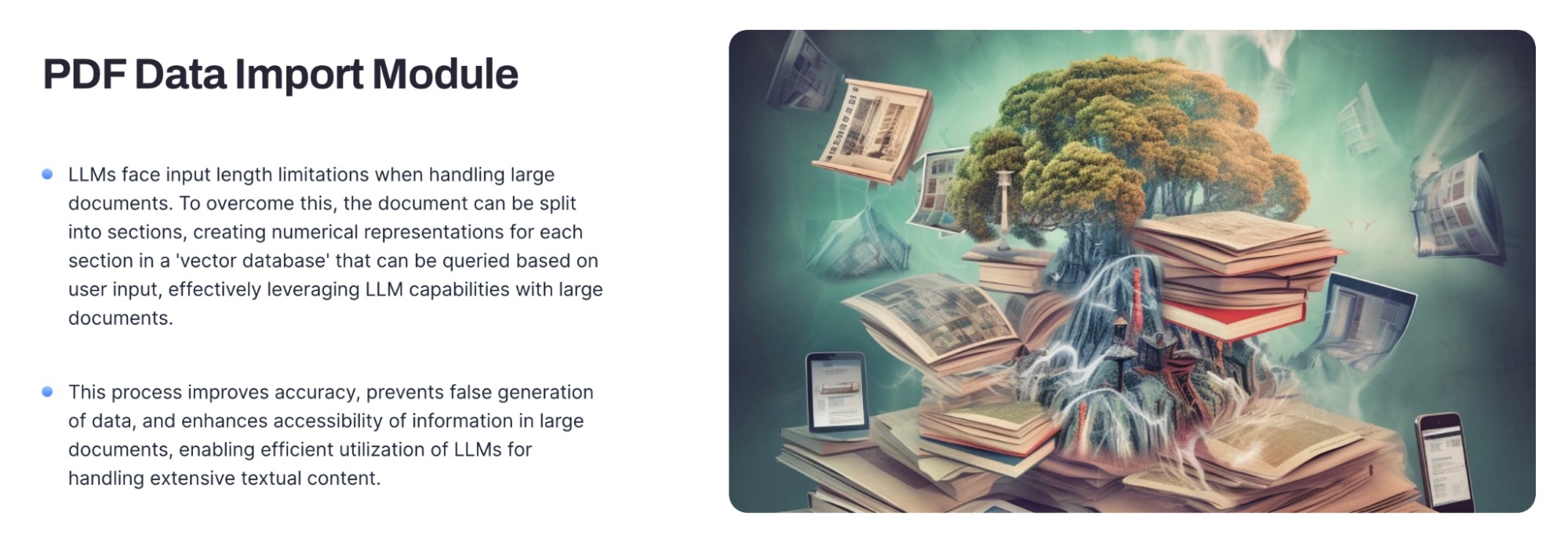
Modules enable users to construct a comprehensive AI solution within their applications, integrating all the essential components. By leveraging the power of Streamlit within the Clarifai platform, Modules relieve developers and data scientists from juggling multiple platforms and tools. Core to Modules' design principle is a seamless unification of AI-building processes under one roof. This unification eradicates the inefficiencies and complexities of integrating UI components into applications. Instead of contending with disparate elements, you're now empowered to build an application with your focus channeled into solving the problem.
Secondly, Modules promise to streamline your experience with common machine-learning tasks. Drawing on the capabilities of the Streamlit-powered UI and Snowflake’s data stack, Modules convert complex procedures into straightforward, repeatable tasks. This enhanced process efficiency reduces the chances of errors and hiccups, translating to a smoother, more enjoyable creation journey. Whether you're integrating with input data in the cloud, augmenting it with annotations, creating models and workflows, or manipulating vectors, Modules expedite and simplify every step.
Lastly, Modules bring a refreshing change to your interaction with user interfaces. As developers and data scientists, UIs are your canvas — a medium for creative expression and problem-solving prowess. Modules powered by Streamlit turn this canvas into a more elegant, user-friendly experience. In doing so, they alleviate the frustrations associated with building and deploying AI applications, making your development journey more efficient and enjoyable.
For domain experts, the world of AI becomes significantly more accessible with the introduction of UI modules. Previously underserved by the platform, domain experts now find themselves able to complete tasks with more efficiency and less dependence on developers. Modules provide a user experience tailored to both their needs and those of their experienced developer counterparts, bridging the gap between the two.
For developers and data scientists, the integration of UI modules serves as a tool for both building user experiences and automating routine tasks associated with AI development. These modules improve prior frustrations by offering more friendly and elegant UIs for common tasks. Consequently, developers can spend more time addressing complex challenges, knowing that routine tasks are well taken care of.
Thinking back, the process of providing a user interface for AI applications involved using separate utilities outside the Clarifai platform, which made the process rather unwieldy. After building the AI component in Clarifai, developers were then tasked with attaching the UI independently — a process that was often messy from an operational standpoint.
However, the integration of UI modules within the platform changes this narrative entirely. The UI no longer stands as a distinct, disparate element to be added onto the application later. Instead, the UI is treated as an integral component of the AI application — a piece that Clarifai's platform handles with professional quality — eliminating the need for developers to manage separate machine-learning operations.
Modules also enable the design and implementation of custom workflows within the Clarifai platform. Processes become markedly more efficient by tailoring workflows to align with unique business requirements. Moreover, backend processing tasks can now be performed within the Clarifai infrastructure to leverage Python's robust ecosystem and computational capability.
A further advantage of Modules lies in their ability to facilitate seamless integration with external systems and services — a crucial attribute when considering the current technological landscape's interconnected nature. This capability enhances Clarifai's interoperability and expands its potential use cases, making it a platform ready to tackle an extensive range of AI development needs.
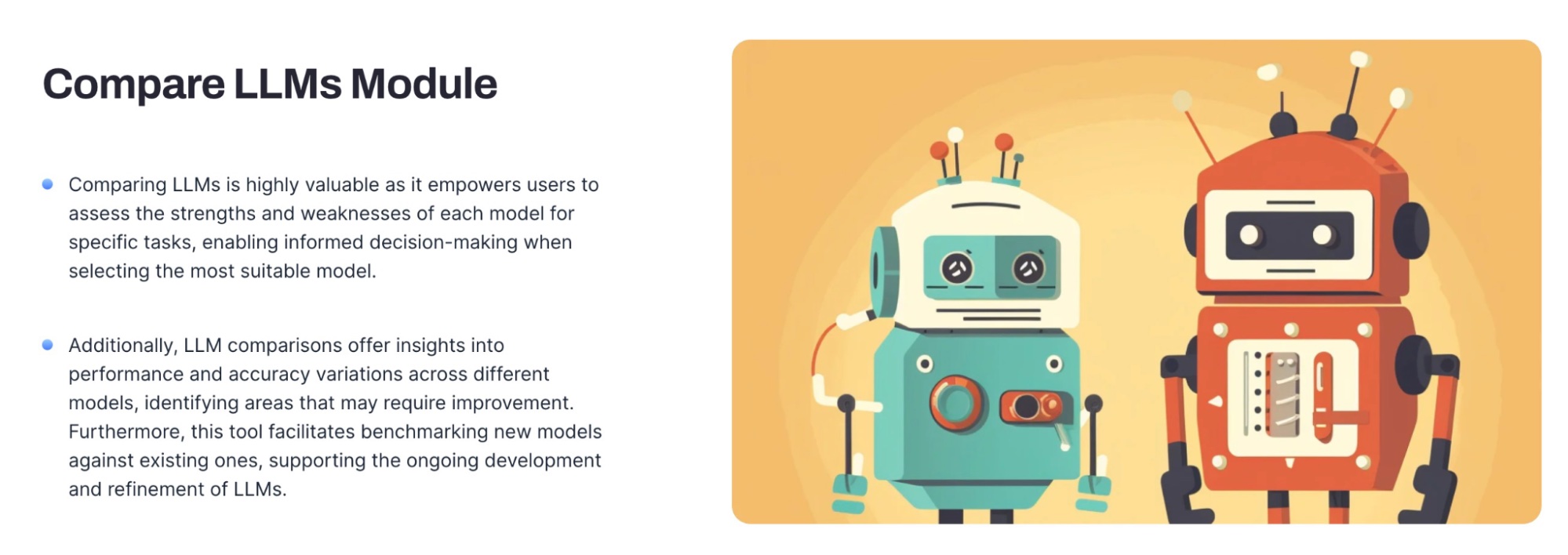
Through a fruitful collaboration with Streamlit, we've brought an alluring tool — beloved by developers — directly into the heart of the Clarifai platform. With this integration, the era of switching between different platforms and tools becomes a thing of the past. Developers are now afforded an opportunity to construct and refine AI applications — completely within the seamlessly integrated experience that Clarifai’s Modules offer.
But our integration with Streamlit is not merely a feature — it underscores our commitment to our developer community. It embodies our pledge to provide you with a comprehensive AI-building platform that transforms the strenuous task of managing multiple platforms and tools into a seamless, efficient workflow. With Modules, Clarifai underlines its ongoing efforts to realize a tailored, all-in-one platform that evolves alongside our developers and caters to their evolving needs.
Furthermore, Modules serve as a catalyst for a rich, thriving developer community and ecosystem. They inspire innovation and cultivate a culture of knowledge sharing. As developers collaborate and share their unique gains with the Clarifai community, we witness the birth of a diverse range of applications extending Clarifai's capabilities.
Beyond fostering a collaborative community, Modules facilitate the creation of tailored solutions to specific business needs and niche use cases. This adaptability opens the doors for developers and businesses to deliver unique value propositions, setting them apart from competitors in the same space.
Finally, Modules are designed with the future in mind. It isn't just that they adapt to your evolving business needs — they're built to evolve alongside the Clarifai platform. This feature future-proofs your AI solutions, ensuring that your tailored functionalities and integrations stay effective and compatible as technology advances.
The versatility of Modules is better demonstrated through real-life application examples that significantly benefit from this new feature in the Clarifai 9.6 release. Let's take a look at how Modules can be deployed in various AI tasks and the practical impact they bring to these processes:
By providing solutions for a wide range of tasks in the AI development lifecycle, Modules not only improve the efficiency of individual operations but also allow developers to focus mainly on the core logic of the problem. By demystifying complex AI-related tasks, Modules will pave the way for accelerated AI adoption.
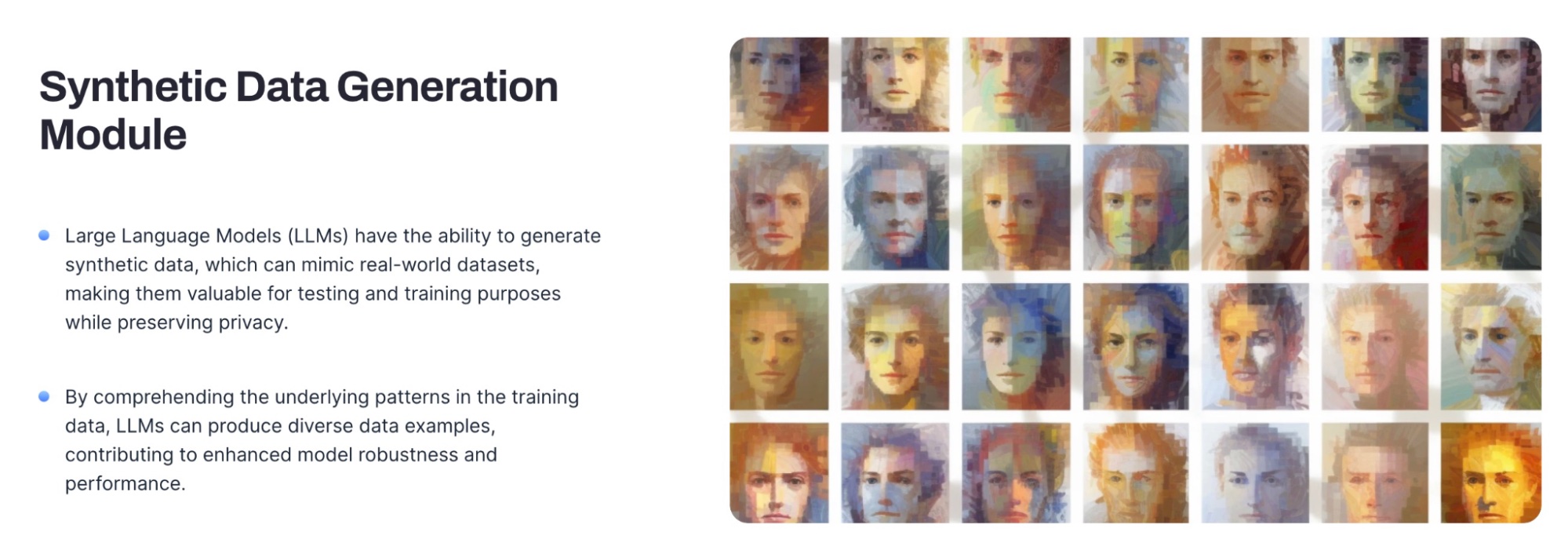
In the rapidly advancing field of AI, the 9.6 release of the Clarifai platform introduces Modules as a revolutionary tool designed to address developers' and data scientists' long-standing challenges. Modules — born from a fusion of inspiration, innovation, and the drive to simplify AI development — herald a new era of efficient, inclusive, and comprehensive AI application development and deployment.
As a product resulting from the thoughtful integration of Streamlit into the Clarifai platform, Modules serve to alleviate the complexities of intertwining UI elements into your applications. Additionally, incorporating Snowflake’s data stack allows Modules to offer a simplified and efficient way to manage your backend processing tasks.
Looking past the severe hurdles of UI integration and backend processing, Modules also combat another prevalent pain point: the deployment of AI applications. Developers wrestled with a multitude of complex and often makeshift solutions prior to deployment — a challenge that Modules serve to eliminate.
Modules extend beyond solving these challenges to open up a world of possibilities. From providing a user-friendly experience for both developers and domain experts to offering a more streamlined AI-building process and unified platform, Modules are game-changers on multiple fronts.
These features foster an active developer community, inviting innovation and knowledge sharing on a platform that can tailor solutions to specific business needs and niche use cases. With future-proofing at its core, Modules ensure that your solutions adapt and evolve as your business needs change or the Clarifai platform evolves.
Seeing these solutions in real-life applications demonstrates Modules' practical impact — whether it's constructing efficient data annotation tools, streamlining the dataset exploration phase, aiding in model performance debugging, or facilitating the design and implementation of custom workflows.
Not just a feature, Modules represent empowerment — the very embodiment of our commitment to providing developers with a comprehensive AI-building solution. Clarifai’s collaboration with Streamlit, fueled by our shared dedication to open-source technologies, vendor-agnostic principles, and our community of developers, brings you a superior AI-building platform that grows and evolves with you.
We invite you to experience the transformative power of Modules in your AI building and deployment journey. Discover the seamless integration of elements, the intuitive UI, and the streamlined processes — and see how Modules can make your working life simpler and more efficient.
Remember, this is just the beginning. As we continue to enhance and expand Modules' capabilities, we encourage you to share your feedback and insights with our thriving Clarifai community. Just as Modules grew from a Hackday's inspiration, your next AI-building endeavor could spark the next big thing for the Clarifai platform.
© 2023 Clarifai, Inc. Terms of Service Content TakedownPrivacy Policy






© 2023 Clarifai, Inc. Terms of Service Content TakedownPrivacy Policy